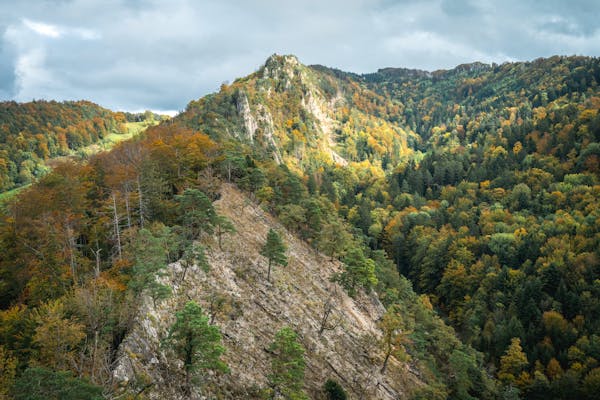Understanding the 4 Levels of Mountain Hiking. Mountain hiking is a thrilling exertion that offers adventure, exercise, and a connection to nature. Still, mountain hikes can vary greatly in difficulty, and understanding the 4 situations of mountain hiking helps trampers choose the right trails for their skill position and prepare effectively. This companion covers each position in detail, from freshman to expert, offering tips for success and safety for each stage of mountain hiking.
1. Position 1 Beginner Mountain Hiking
Characteristics of Level 1 Trails
position 1 mountain hikes are ideal for newcomers and those new to mountain trails. These trails are fairly flat, easy to navigate, and well-marked, with gentle inclines that don’t bear expansive experience or fitness. Freshman trails generally cover short distances and avoid specialized terrain, making them perfect for erecting introductory hiking chops and confidence in the mountains.
Essential Gear for Level 1 trampers
While position 1 mountain hiking doesn’t bear technical gear, trampers should still bring rudiments like water, snacks, a chart, and rainfall-applicable apparel. Comfortable, probative hiking shoes are recommended, but heavy thrills aren’t necessary for these easier trails. Understanding the 4 Levels of Mountain Hiking. Dressing in layers and carrying a light pack prepares newcomers for minor changes in temperature while keeping the hike pleasurable.
2. Position 2 Intermediate Mountain Hiking

Adding Difficulty and Elevation
Level 2 mountain hikes introduce further grueling terrain and moderate elevation earnings. These hikes bear an advanced position of fitness, as the trails can be steeper and longer. Trampers at this position should be comfortable with uneven ground, rocky paths, and gradations but sustained climbs. Intermediate hikes are excellent for those looking to push their limits slightly and ameliorate their abidance.
Structure Abidance for Intermediate Hikes
To prepare for position 2 mountain hiking, it’s essential to work on cardio and leg strength, which help with stamina on steeper trails. Exercises like stair climbing, lunges, and regular hiking practice make the fitness demanded for intermediate trails. Carrying a well-balanced day pack with water, snacks, and navigation tools becomes important in this position to ensure safety and comfort during longer hikes.
3. Level 3 Advanced Mountain Hiking
Challenging Terrain and Specialized Sections
position 3 mountain hikes involve grueling and specialized terrain that requires solid hiking chops and physical abidance. Trails may include steep inclines, narrow paths, rocky or loose shells, and indeed occasional scrabbling sections where hands are demanded for balance. Understanding the 4 Levels of Mountain Hiking. Advanced hikes bear an advanced fitness position, as they frequently cover longer distances and advanced elevations, pushing trampers to their limits.
Essential Gear and Preparation for Level 3 Hikes
Advanced mountain hiking demands technical gear, similar to touring poles, sturdy hiking thrills, and a navigation outfit like a GPS or chart and compass. A comprehensive first aid tackle, along with rainfall-resistant apparel, is essential, as Level 3 hikes can take trampers into remote areas where quick backing may not be available. Preparation includes conditioning for abidance, and being comfortable with elevation and rugged geographies.
4. Level 4 Expert or Technical Mountain Hiking

Tackling Extreme Conditions and Technical Climbs
position 4 mountain hiking is for educated trampers and perambulators who are familiar with navigating grueling terrain and specialized climbing sections. These hikes frequently involve high elevations, alpine surroundings, and routes with steep gemstone faces that may bear climbing gear. Expert hikes are generally set up in mountainous regions with changeable rainfall, adding to the difficulty and pitfalls involved.
Safety and Chops for Expert Trampers
Expert mountain hiking requires advanced chops in navigation, climbing, and rainfall assessment. Trampers need to be equipped with specialized gear like harnesses, ropes, helmets, and ice axes if the terrain calls for it. Experience in mountaineering, along with knowledge of avalanche safety and exigency survival chops, is essential. Understanding the 4 Levels of Mountain Hiking. This position demands internal adaptability, high physical fitness, and proper planning for the unique challenges of expert terrain.
5. Why Knowing the 4 Situations of Mountain Hiking Is Important
Choosing the Right Trail for Your Skill Position
Understanding the 4 situations of mountain hiking helps trampers choose trails that match their skill position, enhancing both safety and enjoyment. Newcomers can start with Level 1 or 2 trails to gain experience, while seasoned trampers can challenge themselves with Level 3 or 4 hikes. By opting for the right trail, trampers can enjoy a satisfying experience without taking on gratuitous pitfalls.
Preparing duly for Each position
Each position of mountain hiking requires a different approach to medication, from gear selection to physical training. Being well-prepared for the position of difficulty ensures that trampers are equipped to handle trail conditions and can safely reach their destination. Understanding the 4 Levels of Mountain Hiking. Preparation not only improves safety but also boosts confidence, making each hike more pleasurable and fulfilling.
Quick Tips for Enjoying the 4 Situations of Mountain Hiking

- Start at Your Position: Begin with easier trials to gain skill and confidence before advancing.
- Invest in Quality Gear: Having the right outfit for your hiking position can make a big difference.
- Train for Stamina: Physical fitness is crucial, especially for advanced situations with steep terrain.
- Respect Nature: Follow Leave No Trace principles to cover the natural terrain.
- Prepare for Weather Changes: Mountain rainfall can change fleetly, so bring layers and rain protection.
Key Points for Each Level of Mountain Hiking
1st Level: Beginner Mountain Hiking
- Trail Difficulty: Easy trails with mild elevation changes, perfect for beginners or casual hikers.
- Average Duration: Typically under 3 hours; shorter distances make it accessible for all fitness levels.
- Skills Focus: Basic trail etiquette, hydration management, and familiarizing with map reading.
- Ideal for Families: Suitable for all ages, including children, allowing families to hike together.
Level 2: Intermediate Mountain Hiking
- Trail Difficulty: Moderate trails with varied terrain, some inclines, and possible rocky sections.
- Average Duration: 3-6 hours, suitable for day hikes with more intense physical effort.
- Gear Needed: Lightweight daypack with water, snacks, and a map; trekking poles may also be helpful.
- Progression in Skills: Builds on basic skills by focusing on pacing, trail navigation, and hiking in varying weather.
3rd Level: Advanced Mountain Hiking
- Trail Difficulty: Strenuous trails, steep climbs, and rough or uneven paths.
- Average Duration: Often 6+ hours and may require a full day, pushing physical limits.
- Equipment Focus: Durable hiking boots, trekking poles, weather-resistant layers, and a full daypack.
- Mental and Physical Challenge: Requires resilience, physical endurance, and advanced preparation.
Level 4: Expert or Technical Mountain Hiking
Trail Difficulty: Extremely challenging terrain that may involve climbing, scrambling, or navigating alpine paths.
Average Duration: Full-day or multi-day hikes; often require overnight camping or backcountry skills.
Specialized Equipment: Technical climbing gear, ropes, harnesses, helmets, and emergency supplies.
Knowledge and Experience Needed: Proficiency in mountaineering techniques, wilderness survival, and risk assessment.
FAQs About the 4 situations of Mountain Hiking
- Do I need special training to start Level 1 hiking?
- No special training is needed for position 1 hiking, but having comfortable footwear and carrying rudiments like water and snacks is recommended.
- How do I know if I’m ready for position 3 or 4 hikes?
- Trampers ready for position 3 or 4 should be physically fit, educated with steep and specialized terrain, and confident in navigation and out-of-door survival chops.
3. What gear is essential for position 4 mountain hiking?
- Position 4 hiking frequently requires specialized gear, including ropes, harnesses, helmets, and occasionally ice axes or crampons for alpine surroundings.
4. Can I start with Level 2 if I’m reasonably fit but new to hiking?
- Yes, if you’re already physically active, Level 2 trails are a good starting point. However, it’s wise to start with shorter Level 1 hikes to familiarize yourself with outdoor hiking techniques.
5. What’s the best way to train for Level 3 hiking?
- Build endurance with regular cardio exercises, such as running, cycling, and stair climbing. Add strength training, especially for legs, and incorporate hill hikes to practice ascending and descending.
FAQs About the 4 situations of Mountain Hiking
6. Is it necessary to hike with a partner at higher levels?
- While not mandatory, it’s strongly recommended to hike Level 3 and Level 4 trails with a partner for safety, especially in remote or challenging areas where assistance may be limited.
7. How do I transition from Level 2 to Level 3?
- Gradually increase your hiking distance, elevation gain, and difficulty of terrain. Practice navigation skills and consider joining guided hikes or hiking groups to gain experience on more challenging trails.
8. What are some signs that a hike might be too difficult for me?
- Feeling overly fatigued, out of breath, or experiencing dizziness are warning signs. If you struggle to keep up with the trail’s pace or feel mentally unprepared, it’s better to turn back and build your skills gradually.
9. Is special insurance required for expert-level hikes?
- For Level 4 hikes, especially in remote or international mountain ranges, having travel or adventure insurance that covers hiking and mountaineering is highly recommended for added protection.
10. What’s the best way to learn mountaineering skills for Level 4?
- Take mountaineering courses offered by certified outdoor schools, focusing on climbing, navigation, avalanche safety, and emergency response. Practicing with experienced climbers is also a great way to learn.
FAQs About the 4 situations of Mountain Hiking
11. Do I need to bring a map for Level 1 and Level 2 hikes?
- While many beginner and intermediate trails are well-marked, having a map or trail app is still advisable for reference, especially in unfamiliar areas or to track progress.
12. How does weather affect the difficulty level?
- Weather can increase the difficulty of any level. Rain, snow, or extreme temperatures add extra challenges. Always check the forecast and prepare accordingly, especially for Level 3 and Level 4 hikes.
13. What should I do if I feel unwell or injured on the trail?
- Stop and assess your condition. Use first-aid supplies if necessary, rest, and hydrate. For serious injuries or sickness, return to the trailhead or seek help. For remote trails, a personal locator beacon can be life-saving.
14. Are there age restrictions on advanced and expert mountain hiking levels?
- While there aren’t specific age restrictions, high levels of physical fitness and experience are required. Many Level 4 trails or mountaineering routes require adult supervision for younger hikers or require participants to be 18+.
| Hiking Level | Trail Difficulty | Ideal For | Key Gear |
| Level 1: Beginner | Easy trails, mild elevation changes | Beginners, families | Comfortable shoes, water, snacks |
| Level 2: Intermediate | Moderate trails with varied terrain | Intermediate hikers, fitness-focused | Daypack, trekking poles, map |
| Level 3: Advanced | Strenuous trails with steep climbs | Advanced hikers, endurance seekers | Durable boots, weather layers, full daypack |
| Level 4: Expert | Technical climbs, high elevations, extreme terrain | Expert mountaineers, skilled hikers | Climbing gear, GPS, emergency equipment |
Conclusion
Progressing Through the 4 Situations of Mountain Hiking
Finding Adventure and Growth at Every Position
Mountain hiking offers challenges and prices at every position, from peaceful ambles through nature to the exhilaration of conquering a specialized ascent. Understanding the 4 Levels of Mountain Hiking. Understanding the 4 situations of mountain hiking allows trampers to progress safely and confidently, chancing adventure suited to their chops. Each position provides openings for growth, discovery, and connection with the natural world, making mountain hiking a continually satisfying trip.
Embrace the Journey and Prepare for Each Step
Whether you’re a freshman or an expert, mountain hiking provides a pathway to particular achievement and out-of-door enjoyment. By embracing the 4 situations of mountain hiking and preparing courteously for each challenge, trampers can safely explore different geographies, experience stirring views, and develop a lasting love for the mountains.
In conclusion, the 4 situations of mountain hiking give a structured way to understand and enjoy mountain trails. With the right medication, mindset, and respect for the natural terrain, trampers at every position can witness the beauty and excitement of mountain hiking safely and responsibly.






One thought on “Understanding the 4 Levels of Mountain Hiking”